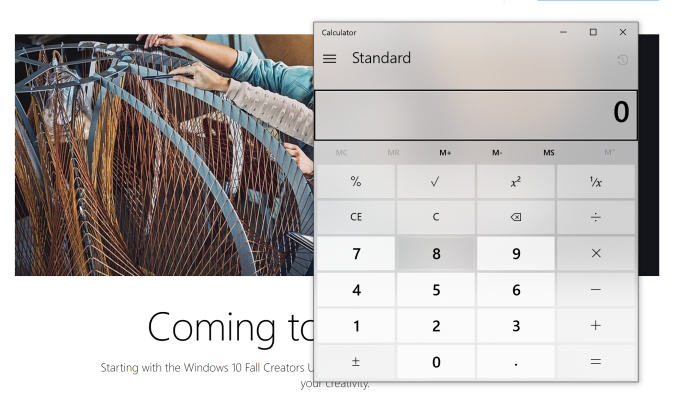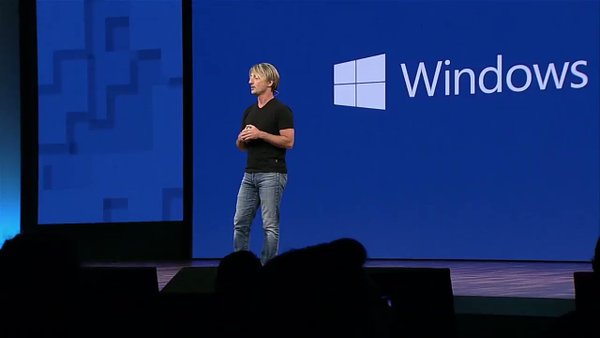The Windows 10 Fall Creators Update Feature Focus
by Brett Howse on November 10, 2017 8:00 AM ESTFluent Design
First announced at the Build 2017 developer’s conference, Fluent Design is the first major overhaul of the Windows 10 design and theme since Windows 10 washed away the remnants of Windows 8 back in 2015. Overall, the original design of Windows 10 has served it well, and it has been made clear after using it for the last several years that lessons were certainly learned from Windows 8, and those lessons were applied to Windows 10 to make a much more coherent and usable design language. But, as with anything, there’s always room for improvement, and the Redmond company is hoping that Fluent Design not only improves on the original, but keeps the UI and theming fresh.
Windows 10 runs on many different devices. The scalability of it is somewhat amazing, and after years of wanting to consolidate it’s OS efforts across device categories, it seems to have finally happened with Windows 10. But that brings some challenges as well, and as hardware has continued to evolve, we’ve started to see many different usage scenarios that traditional mouse and keyboard input would never work on. Touch, of course, is the most obvious and pervasive of these, and falls into the 2D category of input methods, along with keyboard and mouse, stylus, and more of the input methods we are used to. But we now live in a world with virtual reality, and augmented reality, both which live in the 3D space. There’s also 0D devices, such as the recently announced Cortana powered Harmon Kardon Invoke speaker and similar devices such as the Amazon Echo. IoT is becoming pervasive, and appears to be the next growth target in computing.
Fluent Design targets more than just 2D with five basic concepts: light, depth, motion, material, and scale. It may seems like a simple idea, but the key Fluent Design is that it will work well across different device types, but still be very useful on the traditional PC where Windows 10 still has its largest audience.
The move from Windows 7 to Windows 8 was pretty jarring, and the design language was very much flat and blocky. Windows 10 had already added some of the depth back in, but with Fluent Design they have also brought the essence of Windows 7 Aero back, along with new elements as well.
It’s tough to discuss Fluent Design without seeing it, because it’s not just a static idea. All of the elements tie in together to make the experience easier to navigate, more coherent, and more immersive. Check out this video that Microsoft created for their Dev Day:
Light is one of the key elements for selection, and this is doubly the case when you’re thinking of VR and AR technology, where a light gaze can be your pointer. Subtle highlights in lists give a stronger sense of where you are, and what you’re selecting.
Depth plays a big part too, and in the video you can see how going forward and backward in apps gives the feeling of going into an app or image, and then back out, connecting the experience of movement with where you are. This also plays into the motion, where you’ll see parallax scrolling and more.
Material selection is the transparency effects that will likely remind most people of Aero, but it is much more than just blurring. Instead of just background colors and blur, they will be doing multiple layers with Gaussian blur, exclusion blend, color and tint overlays, and tiled noise texture. The acrylic material can bring additional layering and depth to the app as well, but material is also able to be tied into scale, where if an app is in a windowed mode, it can have some blurring, but in a full-screen view, the blurring is eliminated to create focus on the one app.
Scale is likely the most underrated of them all, but Windows 10 is designed to work on everything from IoT to PC to Xbox to Surface Hub, so scale is critical to creating an app which will work across all of those form factors.
It’s hard to deny that Fluent Design is both form and function. There are design elements that are going to improve usability, but those same design elements also just look great. As we move forward, hopefully we’ll start to see more and more of this appear inside of Windows 10 and in the apps we use.
That’s really the only downside to Fluent Design right now though. There’s some of it sprinkled inside of Windows 10, and there’s work to be done to bring it more prominently to the forefront. The Action Center, for instance, has some elements of Fluent Design, but hovering over one of the notifications doesn’t bring any lighting effects to let you know you’re able to select it. Only some of the built-in apps have support right now. This will come over time, and likely even more slowly for third party apps, but it’s not here yet, at least not to its full extent.














95 Comments
View All Comments
prophet001 - Monday, November 13, 2017 - link
*emddrіver - Monday, November 13, 2017 - link
Facebook, Google, or Amazon also do it but lets be real, how can they monetize on my data? Will a company just suddenly guess what I like and dislike on FB? Do I find search results "adjusted" to my preference? Does Amazon give me different prices and offers than others? Idiocy!Plus, there's no sensitive data about me on my phone but I have all kinds of stuff in my computer like scans of important documents, CVs, etc. No way I let M$ have that.
Screw you - Wednesday, November 15, 2017 - link
As if the average customer will actually ever check certificate information. Most don't even know what a certificate is...And your request concerning firewall protection would be for a very small minority of paranoid techno-geeks who represent an insignificant and small portion of the Windows using population... Enacting a default firewall rule to block everything would make the Windows experience cumbersome and inefficient for MOST users. Things work just fine as they are right now... You really need to get over yourself Mr. Fort Knox.edzieba - Friday, November 10, 2017 - link
It's not going to make it 'less safe' either. Two and a half years after release, and not a single shred of evidence has been uncovered of Microsoft sending your files to themselves. And you can bet security researchers have been looking very closely too.shaikhsimraan - Sunday, November 12, 2017 - link
FRP Bypass APK: https://www.yourtechnocrat.com/frp-bypass-apk/Mo3tasm - Friday, November 10, 2017 - link
Fall creator update is certainly the best Win10 update, features are reasonably polished and the build is just a lot more stable...That being said, Win10 itself is bad.. slower than Win7 or even Win8.1 (and an order of magnitude than any Linux distro), you're forced to use the system in a way that you don't necessarily like, and updates are just shoved up the ass...
ddriver - Friday, November 10, 2017 - link
Yeah, good old w7 is still the best, as long as you keep close attention to what updates you are installing.Unfortunately, m$ took measures against the selective installation of updates, and recently releases those "update bundles", each of which contains all the updates and you definitely don't want on your machine, such as telemetry.
Additionally, m$ colluded with hardware vendors to omit support for w7 from their latest hardware driver packages. Granted, some might actually work, but it is usually hacky and not 100% operational.
Really revolting, heinous, despicable behavior. Grade A scumbags...
Ratman6161 - Friday, November 10, 2017 - link
Here is the other side of the coin. The vast majority of exploits which make it into the news are exploiting know things that only work on systems that have not installed updates. Wannacry was a perfect example.Bullwinkle-J-Moose - Saturday, December 23, 2017 - link
Bad example Ratman!Wannacry had no effect on Windows XP-SP2 with no Microsoft Updates, only SP3 was affected
Once Microsoft updates yer box, NSA exploits work again like magic
Mo3tasm - Friday, November 10, 2017 - link
I suspect it also has to do with frequent updates, developers can get lazy all they want when they must fix bugs or optimize performance, because they can always do it "next month"..Back in the days when you could push major code changes only once per version they had to work really hard to perfect every line of code.